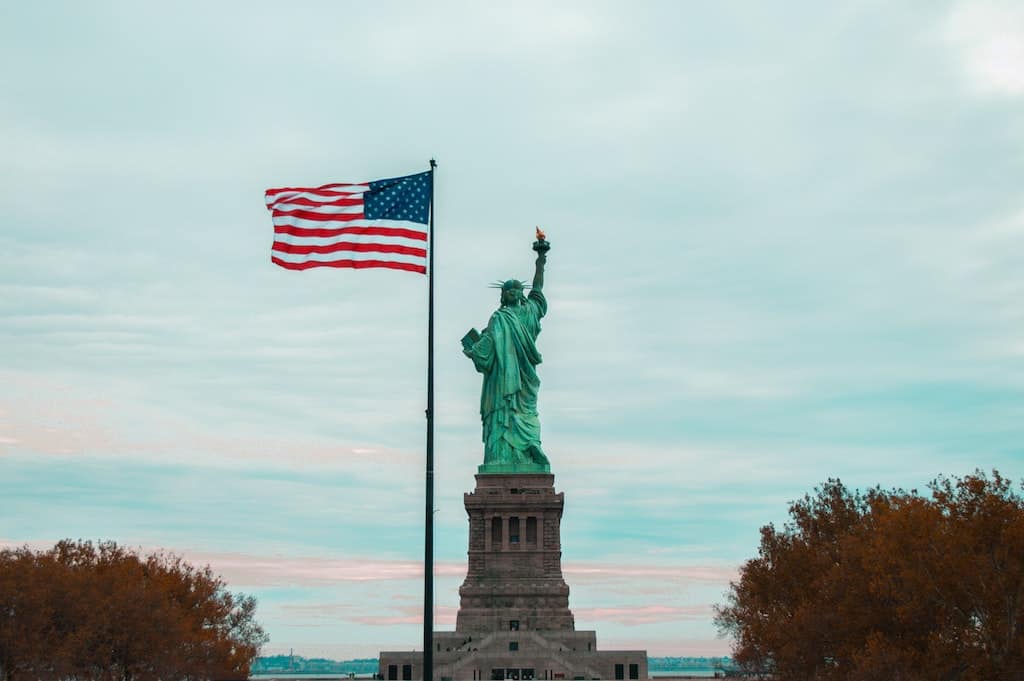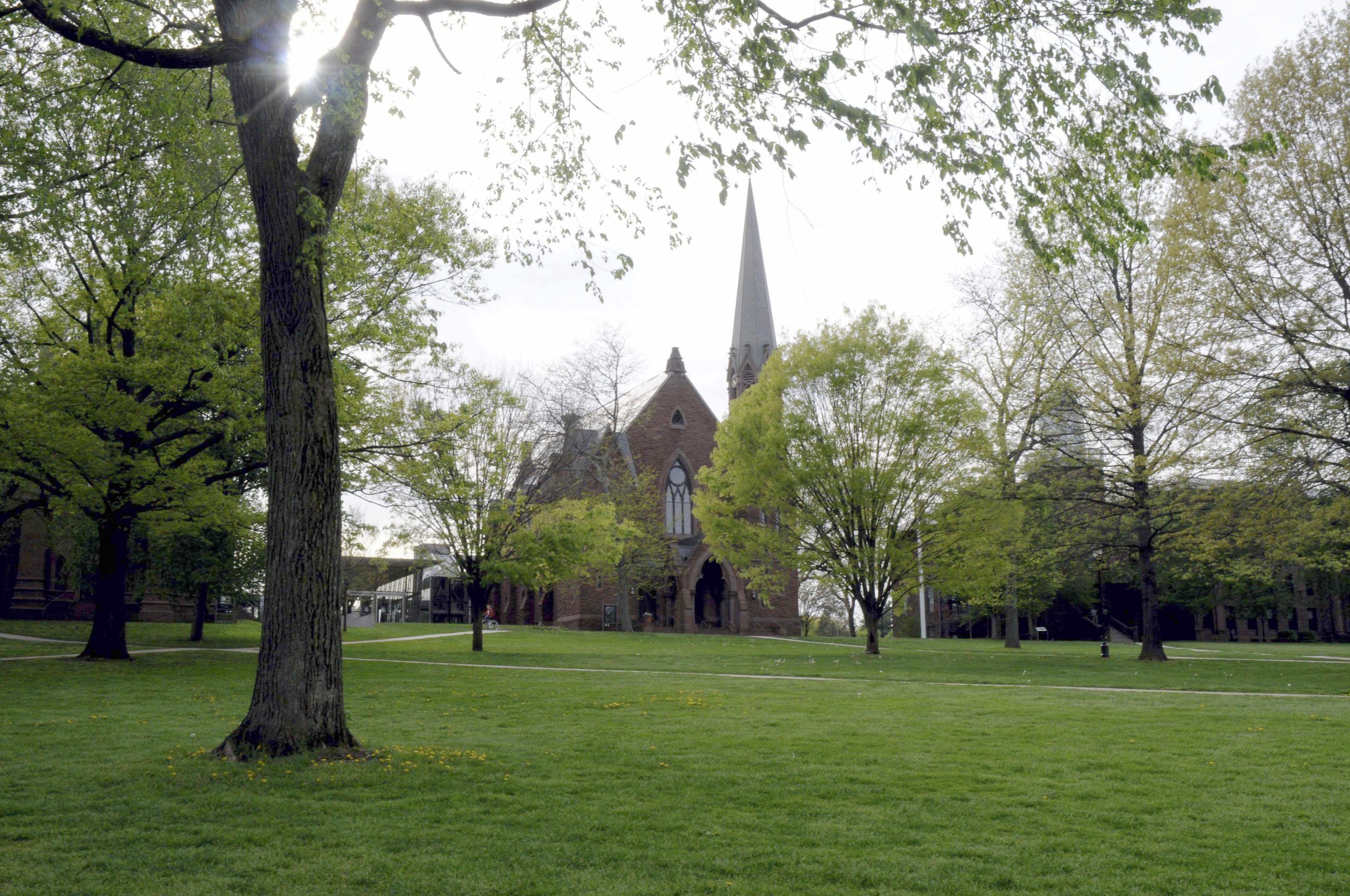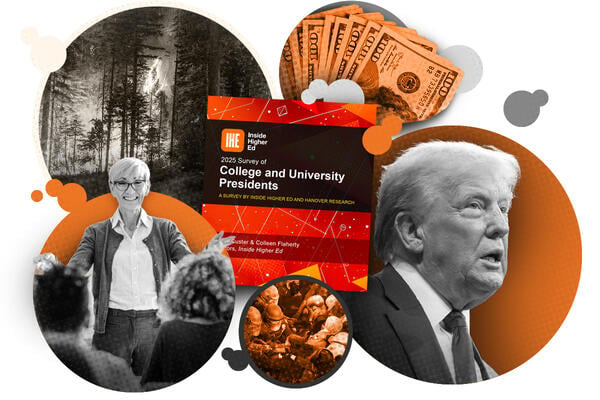College presidents showed tepid support for tenure with a little more than a third agreeing that the pros outweigh the cons, according to Inside Higher Ed’s 2025 Survey of College and University Presidents, conducted with Hanover Research and released in full today.
That was just one of many findings across the annual survey, now in its 15th year.
Presidents were optimistic in some areas, with most expressing confidence that their institutions will be financially stable over the next five to 10 years and positivity about the job itself. But campus leaders also expressed concerns about politicians trying to shape institutional strategies, which they see as an increasing risk, plus a seeming lack of improvement on undergraduate mental health, even as campuses make more investments in related services.
Inside Higher Ed earlier this month released a portion of the survey findings that unpacked how presidents viewed the second Trump administration. The bulk of the survey’s political findings were covered in that initial release, with college presidents largely worried President Donald Trump will negatively affect higher education in this new term.
This year’s survey included responses from 298 respondents across two- and four-year institutions, including public, private nonprofit and a small number of private for-profit colleges.
More on the Survey
Inside Higher Ed’s 2025 Survey of College and University Presidents was conducted with Hanover Research starting in December and running through Jan. 3. The survey included 298 presidents of two- and four-year institutions, public and private, for a margin of error of 5 percent. Download a copy of the free report here.
On Wednesday, March 26, at 2 p.m. Eastern, Inside Higher Ed will present a webcast with campus leaders who will share their takes on the findings. Register for that discussion here.
Faculty Tenure
Tenure is often championed by professors and presidents alike for the protections it provides when it comes to issues of academic freedom. But just over a third of college presidents surveyed here—37 percent—indicated that the pros of tenure outweigh the cons.
By institution type, presidents at public doctoral universities were most likely to support tenure, with 82 percent agreeing that the pros outweigh the cons.
The overall finding came as a surprise to some observers, especially as politicians in some states are increasingly taking aim at tenure.
Anne Harris, president of Grinnell College in Iowa, said she was surprised that presidential support was so low, adding that tenure plays an important role at liberal arts colleges, such as the one she leads.
“For the small liberal arts college model, tenure is the continuity of mentorship, of advising, of those long-term relationships that we rely on … to see students through, to high graduation rates, to all those things,” she said. “From my perspective, the pros are very, very salient for what tenure does, not just for academic freedom and for the pursuit of research, but also for what it does for the continuity of advising and mentoring for students.”
Michael Harris, a professor of higher education at Southern Methodist University (and no relation to the Grinnell College president), noted tenure can “be a thorn in the side of presidents and provosts” but that it can also serve as a buffer to political attacks on academic freedom.
“It’s disappointing to me that presidents don’t have a better opinion of tenure, particularly in this current moment. I understand the challenges that tenure causes, and how it might limit the institution financially, or in decision-making—well-known areas where tenure can slow things down. But at this moment it’s just disappointing to me that there wasn’t more belief in tenure,” Harris said.
Yet he believes that even the presidents who don’t like tenure will continue to protect it.
“Presidents understand—even if tenure is a pain for them to deal with—the damage it would do to them in recruiting faculty [to lose tenure]. So there’s a self-interested argument on keeping tenure, even if they personally would like for the whole industry to get rid of it.”
Campus Speech
After pro-Palestinian student protests broke out on campuses nationwide over the bloodshed in the war between Israel and Hamas, many institutions changed their campus speech policies. Almost half of presidents surveyed—45 percent—noted that their institution updated its speech policies within the last 18 months, with public institution leaders most likely to say so.
Additionally, almost a third of survey respondents (29 percent) indicated that their campus has an institutional neutrality policy, according to which college leaders should not comment on social or political matters that do not directly threaten the core mission. Such policies saw an uptick amid the fallout of the recent protests, which many congressional Republicans cast as antisemitic.
Few respondents whose institution does not already have an institutional neutrality policy said it’s likely to adopt one.
Despite recent student protests, presidents overwhelmingly blamed politicians for escalating tensions over campus speech concerns, versus other groups: Some 70 percent said politicians were primarily at fault, while just 18 percent blamed students.
Presidents speaking on a panel about the survey findings at the American Council on Education’s annual meeting in Washington on Feb. 12 suggested campus speech concerns are overblown.
“One incident goes viral, it gets all sorts of publicity,” Jon Alger, president of American University, said, while arguing that “99 percent of campus conversations” typically go well.
Félix V. Matos Rodríguez, chancellor of the City University of New York, also speaking at ACE, said that social media often inflates speech issues with incomplete narratives for the sake of virality. He added that outside actors also weaponize such tensions to further their own political agendas.
In a separate December survey of two- and four-year students by Inside Higher Ed and Generation Lab, nearly all respondents supported institutional efforts to promote civil dialogue, and 40 percent were at least somewhat concerned about the climate for civil dialogue and student free expression at their institution.
Economic Confidence
Presidents surveyed expressed strong financial confidence, despite difficult headwinds for the industry in recent years, which have seemingly been exacerbated by Trump’s recent executive actions threatening funding, prompting hiring freezes and more.
Among respondents, 87 percent signaled that they expect their institution to be financially stable over the next five years, and 83 percent said the same over a 10-year timeline. But nearly half of presidents, 49 percent, believe their institution has too many academic programs and needs to close some. Some 19 percent responded that they had serious merger or acquisition talks recently, about the same as last year’s survey.
This year, most of the presidents weighing mergers cited a desire to ensure their institution’s financial stability and sustainability, rather than risk of closure.
Nine percent of all presidents said it’s somewhat or very likely that their institution will merge into or be acquired by another college within the next five years, with presidents of private nonprofit baccalaureate institutions especially likely to say so (21 percent).
Presidents also saw risks beyond the business side. More than half—60 percent—believe politicians’ efforts to influence strategy are an increasing risk to their institution.
However, some presidents at public institutions see that tension as inherent to the sector.
“I think we’re a little bit naïve if we expect to be totally independent from the voices of our elected officials in helping to set the direction they think is important for the public investment that is being made in our institutions,” said Brad Mortensen, president of Weber State University in Utah.
Presidents of public and private nonprofit institutions expressed similar levels of concern on this point.
Being a President
Most presidents like the job, even if they question how their time is spent. The overwhelming majority of respondents—89 percent—agreed, at least somewhat, that they enjoy being a college president.
Additionally, 88 percent of respondents said that their own governing boards were supportive.
However, more than half—56 percent—question whether the presidency can be capably handled by one person. Presidents also indicated they would prefer to focus on strategic planning, fundraising and community engagement but often find other pressing demands, such as dealing with personnel issues and managing institutional finances, eating into their time.
A quarter of respondents said that the hardest part of the job was navigating financial constraints. Other areas of difficulty that emerged in the survey include too many responsibilities with too little time to do the job, enrollment challenges and external political pressures.
Asked how long they expected to be in their job, a plurality (47 percent) answered five years.
Harris, the SMU professor, is skeptical that most presidents will last that long. He said the finding that nearly half of presidents expected to be in their jobs over the next five years prompted him to “laugh out loud,” and he noted that data from ACE’s latest American College President Survey showed the tenure for college leaders has fallen to just over five years.
“Either a whole bunch of first-year presidents filled out the survey and they’re going to stay another five years, or somebody is missing the boat on how long they’re actually going to serve,” he said. For reference, the plurality of survey respondents, 33 percent, have served as president of their current institution for five to 10 years. The rest were roughly split between less than three years, three to approaching five years and 10 or more years served.
Last year saw numerous high-profile presidents abruptly resign, including from the nation’s wealthiest institutions—some of whom had only been in the job for a matter of months.
Student Mental Health
College presidents also expressed confidence about their institution’s approach to student mental health.
The overwhelming majority reported that their institution has done a good or excellent job of promoting student health and wellness across multiple areas. On mental health, in particular, 81 percent said this. And 69 percent said that their institution has been effective in addressing the student mental health crisis, though only 37 percent felt the same was true of the sector as a whole.
Despite the confidence in their institution’s efforts, only 44 percent of presidents somewhat or strongly agreed that undergraduate mental health is improving on their campus. Just 23 percent said the same of undergraduate mental health across higher education.
Harris, the Grinnell College president, suggested that finding may not be cause for alarm but rather for deliberation. She noted that “more students accessing mental health resources, to me, is not necessarily a sign of a mental health crisis, it’s a sign of mental health self-advocacy.” Still, she said that colleges still need to develop a better understanding of student mental health issues.
Other Findings
Artificial intelligence is another category that prompted mixed feelings.
About half of respondents—51 percent—believe their institution is responding adeptly and appropriately to the rise of AI, but only 29 percent said the same was true across the sector.
About the same share over all (52 percent) said their institution had established a campuswide AI task force or strategy.
Survey respondents noted that the most common uses for AI for their institutions included virtual chat assistants and chat bots, research and data analysis, predictive analytics to identify student performance and trends, learning management systems, and use in admissions processes.
A third of presidents (32 percent) said their institution has set specific climate-related or environmental sustainability goals. Institutions in the Northeast and West appeared to lead here and on other sustainability-related questions, by region.
The survey period ended Jan. 3, ahead of Trump taking office for a second term and ahead of his administration issuing a Dear Colleague letter attempting to dramatically widen the scope of the Supreme Court’s 2023 ruling against affirmative action in admissions in Students for Fair Admissions v. Harvard.
At the time of the survey, nearly all presidents (88 percent) said their institution had been able to maintain or increase previous levels of student diversity since that Supreme Court decision. Looking only at presidents whose institutions previously practiced affirmative action (n=22), closer to half said they’d been able to maintain or increase previous levels of diversity.
Separately, 10 percent of all presidents said their institution had curtailed diversity, equity and inclusion efforts beyond admissions since the decision, with presidents in the South and Midwest likeliest to say this, by region.
Groups such as ACE have cautioned against anticipatory compliance to the Education Department’s Dear Colleague letter, which does not have the force and effect of law. Other legal experts note that the letter is not subject to the current preliminary injunction against parts of two White House executive orders that also seek to limit diversity, equity and inclusion efforts.







